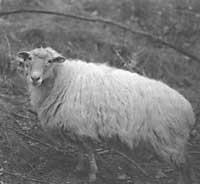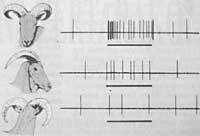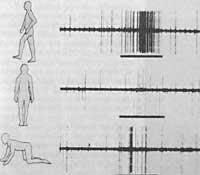Sheep for what?

If we go to the mountain we see a flock of sheep, let us not think that they behave like automatons and that their main concern is that the hayuco is carried only to the mouth. Despite this appearance, they have realized that we are there, they have identified us as human beings and they know if we are going to approach them or not. Sheep are aware of all the changes that occur in their environment and have their senses well adapted to immediately and accurately collect all these changes.
Sheep can see almost all things in the environment, but they have a stricter vision in the anterior area where the vision of both eyes overlaps.
In studies conducted some twenty years ago, experts were able to analyze that sheep, both human and coyote, can be seen at a distance equal to or greater than 900 meters, but also when humans or coyotes are semi-flexed by shrubs or when other circumstances prevent them from relying on odor. Sheep can be based on certain characteristics of the body of the other animal and know its social position. The presence of branches in many varieties and their size indicates the position of this animal in its intermediate hierarchy. The larger the branches, the higher the animal in the group hierarchy. The simple cutting of branches can therefore have enormous consequences on its hierarchical position. The size of the branches also indicates a little, since females do not have horns or how they want them to be smaller than males.

According to other studies, mothers can know what they are and what they are not, looking to the end at lambs. In some experiments some parts of the lamb's body were colored and the mother reacted. When the head was colored (or with the body included), the mother had difficulty knowing her lamb.
Sheep are also thought to use vision to help identify food. Where they cannot smell certain foods, they quickly find their tastes to eat.
In some experiments it has been proven that sheep also see it in colors, but still no one has shown it.
Basically, the brain and eyes of the sheep process some visual images in the same way that people process them. But your visual system has some features. For example, when compared to the eyes of the primate, those of the sheep are not fully adapted to differentiate objects accurately. Their eyes lack the adaptation reflex that is the element that changes the shape of the lens to better focus objects in our eyes. Both sheep and people process the visual image first in the retina, behind the eye. The cell density of the retina indicates a visual precision, which in the sheep is between the cat and the man.

In the next step of the process, the information of the retina passes to the optic nerves, and after being analyzed by the thalamic nuclei reaches the first posterior visual cortex of the brain. According to studies carried out around 1980, the structure and organization of the first visual cortex of the sheep is similar to that of the primates. Unlike new-born primates, lambs have a mature visual crust at birth and, from the first day, can take advantage of their own eyes to take over the environment.
At what point do we know, or do sheep, people, or objects have when processing the image?
It seems that it is not identified until the information is transmitted to other brain structures. In these structures we can find neural populations that modified their activity responding to the observation of specific objects or individuals. These areas also have connection with areas of the brain related to memory and control of emotions and behaviors. Studies on sheep behavior suggest that this species, like primates, may have specialized centers to identify in the brain relevant individuals and foods.
Studies carried out so far have shown that a small cell population of cerebral temporal cortex only decodes faces. This suggests that in sheep, as in primates, this area is specialized in identifying people according to their faces. The condition to these areas in humans can make it difficult to identify the faces.


In the sheep's brain, extra subpopulations of cells are responsible for decoding specific facial groups or face characteristics. Most cells only respond to adintelate extremes and the larger the branches the greater the response. As we can see in figure 2, the record of the response of neurons shows us the influence of branch size. Another cell group responds only to the extremes, and especially to those known, of animals of the same variety. There is also a group of cells that only respond to the human faces and ends of dogs. From this data we can deduce that sheep, therefore, give a different treatment to the information associated with the dominant characteristics, to the extremes of the known sheep, as well as to potentially threatening species such as dogs and humans.
The orientation of extreme stimuli is also important (see Figure 2). The reactions of the frontal images are stronger than those taken laterally or behind the head. Temporal bark cells, unlike primates, do not respond to emerging extremes. Sheep, like primates in trees, may not have to identify with each other in the lower state.
The temporal cortex of the sheep also contains cells that respond to human appearance. The sheep cannot distinguish the different human beings, they cannot determine the sex to which the human being belongs they see, or what they carry, or whether they are presented before or behind them.
In turn, these cells do not respond to these different human characteristics. But the direction in which man moves influences these cells. Most cells only respond to the movement of man towards the sheep. If humans see them laterally or in lauhana, the response to these cells disappears or decreases (see Figure 3).

In another subcortical brain area, the hypothalamus, we find cellular groups capable of visually identifying food. These cells respond by seeing known foods and not to the smell of those foods or objects that are not food. The more we like food, the more response these cells will give. And conversely, when the animal wants to stop eating a certain food, these cells will not respond to the sight of the food.
Several studies have shown that the neural processes that occur in the sheep's brain are similar to those found in monkeys and perhaps in humans. This does not mean that they are as intelligent as the monkey or man. This means that the complex task of the brain to identify something is very similar in the different species.
Another important principle that can be extracted from the subject from the studies carried out so far is that the neural processes that are carried out when identifying something are very close to the processes that govern the emotional or behavioral responses of the sheep. The sheep sees objects in the context of their emotional or behavioral importance. For example, some cells give an egalitarian response by seeing the human face and the end of the dog. The emotional meaning of these two elements is similar, although the physical appearance is different.
The visual analysis of these images is influenced by the possible emotional or behavioral consequences of certain images. For this to happen, there must be a complex interaction between the areas of the brain that control both processes.

Learning, of course, plays an important role in the classification of objects by the brain. At present, for example, the consequences of the growth of animals with hooks without horns are being investigated. Does an inexperienced lamb with horned animals have a cell that responds to horned ends? If you don't, how long will it take to develop these cells?
If we can understand how learning modifies the sensory processes of images and the interaction between emotional and behavioral responses, it can also be beneficial for medicine. In people suffering from schizophrenia or autism, there is often a break between the proper identification and response of objects and individuals. If we know how learning affects the integration of these two processes, we can better understand these changes in the future.





